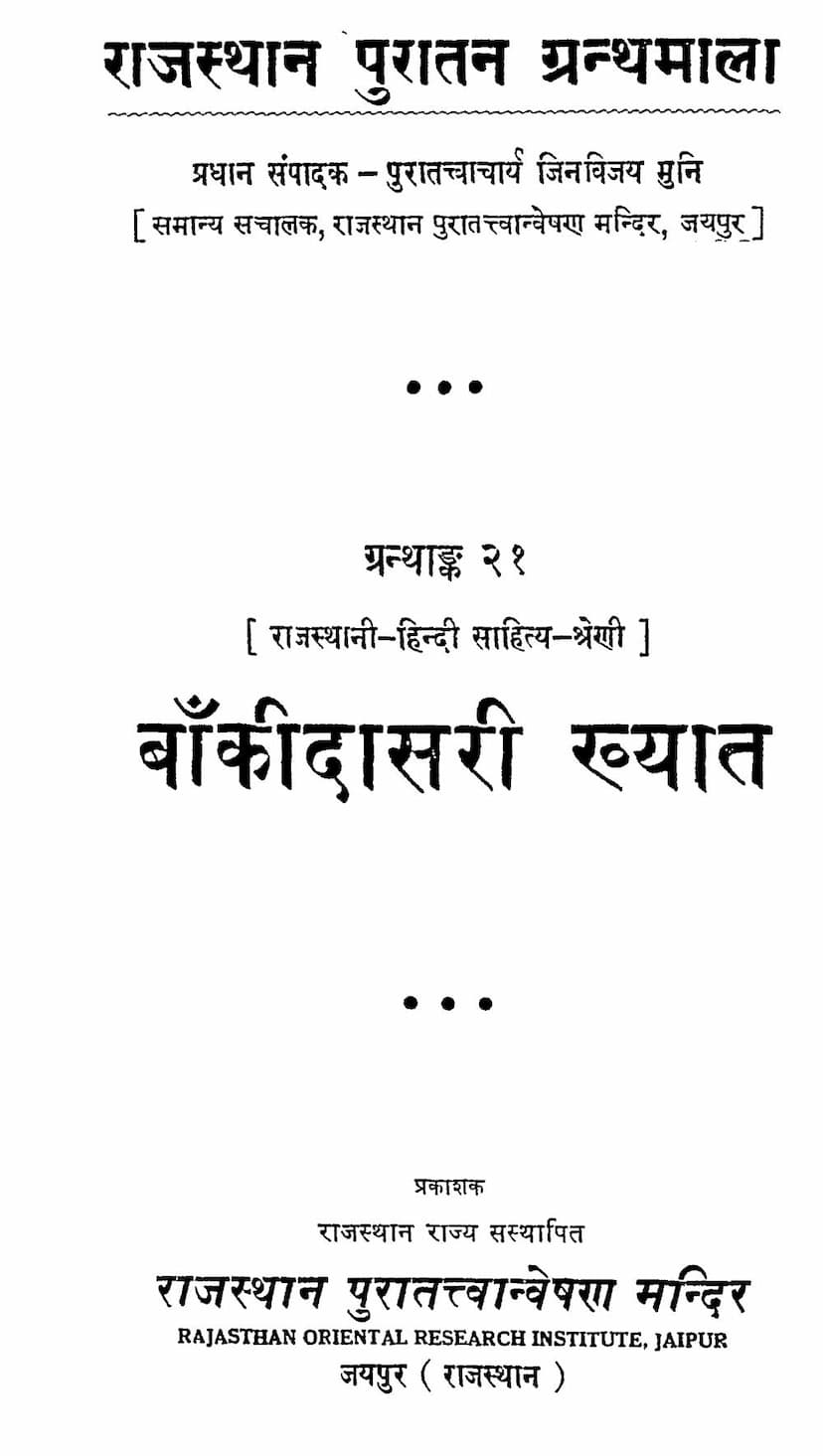Bankidasri Khyat
Added to library: September 1, 2025

Summary
Based on the provided table of contents and scanned pages of "Bankidasri Khyat" by Narottamdas Swami, published by Rajasthan Oriental Research Institute, Jaipur, here's a comprehensive summary in English:
Book Title: Bankidasri Khyat (बाँकीदास री ख्यात) Author: Mahakavi Bankidas (महाकवि बाकीदास) Editor: Pt. Narottamdas Swami (पं० नरोत्तमदासजी स्वामी) Publisher: Rajasthan Oriental Research Institute, Jaipur (राजस्थान पुरातत्त्वान्वेषण मन्दिर, जयपुर) Series: Rajasthan Puratan Granthmala (राजस्थान पुरातन ग्रन्थमाला) - Rajasthani-Hindi Sahitya Shreni (राजस्थानी-हिन्दी साहित्य-श्रेणी) Publication Year: Vikram Samvat 2013 (Vikramaditya 2013), corresponding to 1956 CE.
Overall Summary:
"Bankidasri Khyat" is a significant historical and literary work written in Rajasthani prose by the renowned poet and historian Mahakavi Bankidas. The book is a collection of various historical anecdotes, genealogies, and narratives, often referred to as 'vātāṁ' (वातां), pertaining to the Rajput clans and other communities of Rajasthan and surrounding regions. Edited by Pt. Narottamdas Swami, this publication aims to bring to light the rich historical prose literature of Rajasthan, as part of the Rajasthan Oriental Research Institute's efforts.
Key Aspects and Content:
-
Nature of the Work: The Khyat, as explained in the introduction, is not a continuous, chronological history like some other Khyats (e.g., Dayaldas's Khyat). Instead, it is a compilation of disparate and often brief notes or anecdotes that Bankidas found noteworthy. These 'vātāṁ' are usually only two to three lines long, though some might extend to a couple of pages. The editor, Pt. Narottamdas Swami, has attempted to organize these otherwise unarranged notes into a more coherent structure for the benefit of readers and researchers.
-
Author's Background: Mahakavi Bankidas (1781-1833 CE) was a celebrated poet and historian from the Asiya Charan clan. He held a respected position in the court of Maharaja Mansingh of Jodhpur. Bankidas was known for his patriotic sentiments and strong criticism of Rajput rulers who submitted to British influence without resistance, as exemplified by his famous song "Aayo Angrej Mulkh Re Upar" (आयो अगरेज मुलकरे ऊपर). He was also a scholar of multiple languages, including Rajasthani, Brajbhasha, Sanskrit, and Persian, and had a deep interest in history, which led him to collect historical information throughout his life.
-
Historical Scope: The Khyat covers a vast historical period, primarily focusing on the history of various Rajput dynasties and their associated figures. The "Vishay-Suchi" (Table of Contents) clearly outlines the broad categories of information contained within the book:
- Rajput Dynasties: Detailed accounts of the Vatas (anecdotes) related to prominent Rajput clans like Rathore (राठौड़), Gehlot (गहलोत), Yadav (यादव), Kachwaha (कछवाह), Chauhan (चौहान), Parihar (पड़िहार), Parmar (परमार), etc. The book provides genealogies (piḍhiyāvaḷī) and describes significant events, battles, and relationships of these ruling families.
- Other Communities: Anecdotes related to other significant groups like Marathas (मराठा), Sikhs (सिख), Jogis (जोगी), Oswals (ओसवाळ), Charans (चारण), Muslims (मुसलमान), and even Europeans (फिरंगी).
- Religious and Geographical Information: Miscellaneous information of a religious and geographical nature is also included.
-
Content Breakdown (as seen in the detailed Table of Contents): The detailed listing of 'vātāṁ' reveals the granular nature of the information. For example, under Rathore dynasties alone, there are sections dedicated to their various branches (khāmpāṁ), sub-branches (sākha), ruling lineages (pīṛhiyāṁ), and specific rulers like Sehoji, Asthanji, Dhuhadji, Raypalji, Chundoji, Veermaji, Jodha, Maldeva, Sur Singh, Jaswant Singh, Ajit Singh, Bakht Singh, Vijay Singh, Mansingh, and many more, detailing their lineage, battles, marriages, and significant acts. Similar detailed accounts are found for other major clans.
-
Editorial Contribution: Pt. Narottamdas Swami's significant contribution lies in the systematic organization and editing of Bankidas's raw historical notes. Recognizing the lack of chronological order and the presence of repetitions in the original compilation, the editor has painstakingly arranged the 'vātāṁ' into thematic and chronological sections, making the Khyat accessible and useful for historical research. The editor also mentions the challenges faced due to Bankidas's lack of formal historical writing structure and the need for extensive cross-referencing with other historical sources.
-
Historical and Literary Significance:
- Historical Value: "Bankidasri Khyat" is considered a primary source for reconstructing the history of Rajasthan. It provides valuable insights into the political landscape, social customs, family histories, and military engagements of the period. Its detailed information on genealogies, marriages, and even the origins of certain communities makes it indispensable for historians.
- Literary Value: The work is also appreciated for its authentic Rajasthani prose. Written in the language of the time, it offers a glimpse into the literary style of early Rajasthani historical writings, contrasting with the more poetic forms often found in historical compositions. The editor notes that works like those of Nensi, Dayaldas, and Bankidas represent the pinnacle of early Rajasthani prose.
In essence, "Bankidasri Khyat" is a foundational text for anyone studying the history of Rajasthan, offering a vast and unique collection of historical data compiled by a poet-historian of great repute, meticulously organized and presented by a dedicated scholar.